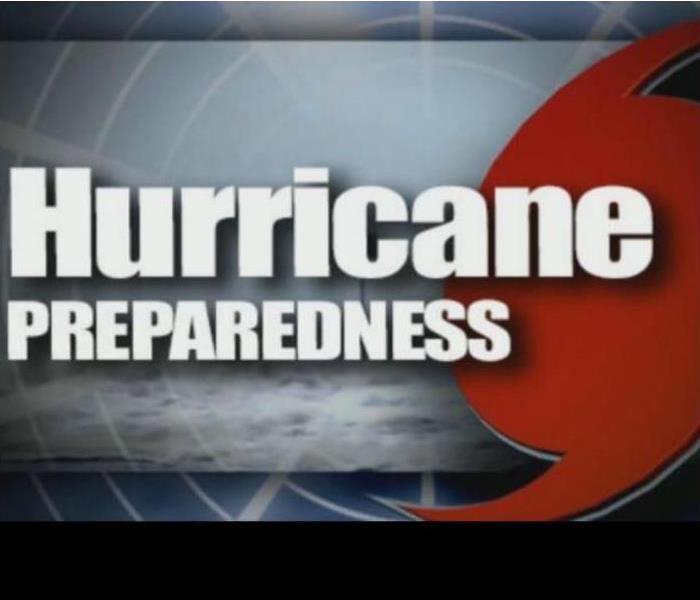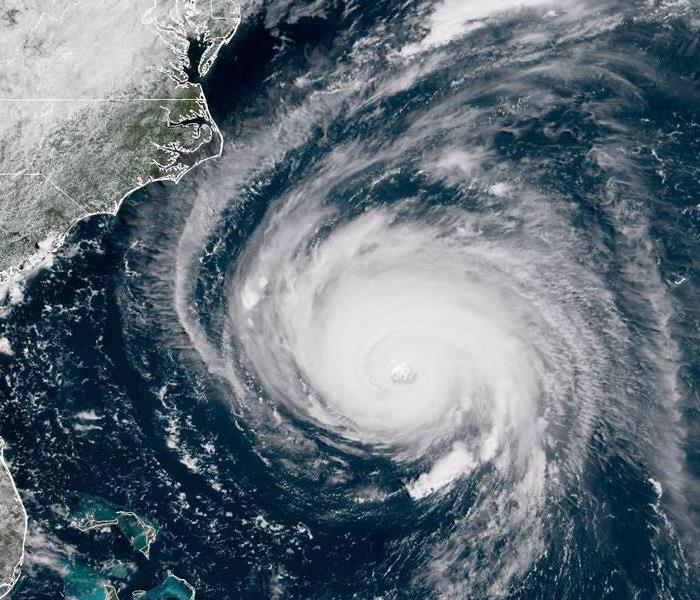Recent Storm Damage Posts
Storm Damage Clean Up Tips
1/14/2022 (Permalink)
The rain has finally stopped falling and the wind has finally died down. The storm finally may be finally over, but the mess it left behind remains.
Here at SERVPRO of Lenoir, Duplin, & Jones Counties, we want to help your landscape recover after a big storm and have it in tip-top shape again.
Before you head outside to clean up the mess, make sure there are no downed power lines or trees leaning on power lines.
- Inspect trees. After storms pass, your trees may be unsafe–especially if you see large fallen branches, a split tree trunk, or a broken tree top.
- Pick up small twigs, leaves and debris. When all is dry, branches make excellent firewood. As for the leaves, compost them and work them into the soil to improve it.
- Clean up smaller branches. If you have examined your tree, and only a few small branches were damaged, you can likely do it yourself. For branches less than 2” in diameter you should be able be able to reach it from the ground without a ladder. If that’s the case, then grab your tree trimming tools and get busy.
- Fix puddles of water on the lawn. If you often spot a small pool in the yard after storms, you’ve got a problem with water runoff in that area. Or if it’s a larger puddle each time, consider filling in the depression or redirecting the water flow. You could also plant shrubs that love water, so they can help soak up the water in that area.
- Help your trees recover. Throughout the year help keep your trees healthy. Healthy trees are less likely to have deadwood break off during storms.
We at SERVPRO of Lenoir, Duplin, & Jones Counties hope you can use these tips to help make your yard safe again.
Can winter storms affect your roof and cause water damage?
1/13/2022 (Permalink)
Roof damage can occur at any time of year, we know that, but winter weather can be especially harsh on a house’s roof and it’s almost never a good idea to simply wait for spring before addressing the issues that the presence of snow and ice on your roof can cause. In most cases, winter weather won’t cause new damage to your roof, however it can exacerbate existing—or even unknown—problems.
Here we list the most common forms of roof damage that can occur during these cold winter months.
Water Damage
Freezing rain can seriously damage your roof. This is particularly problematic if ice builds up in your gutter and prevents water from draining properly from your roof. Extensive water damage can also occur if your area experiences heavy rain and the accumulated water gets under your shingles and into your home. Even just a few inches of water can cause extensive interior home damage by affecting electrical wiring and causing mold to grow inside the home. Both slanted and flat roofs are susceptible to water damage. To prevent water from getting trapped in your roof, ensure that your roof is properly ventilated. If any minor holes or leaks exist, fix them immediately to prevent water from entering at those points.
Snow Damage
This is especially risky if your home’s roof is flat or designed in such a way that snow cannot easily fall down the sides. Snow may melt fairly quickly thanks to the heat emitting from your home; however, it can enter through cracks in your roof if there is more snow on your roof than your gutters can handle. If your roof is old, heavy snow could lead to structural damage, or even a complete cave-in. If you have damaged or missing shingles, or poor sealing around your chimney, flashing or skylights, melting snow can seep through and reveal potentially devastating leaks. To prevent snow damage to your roof after a particularly heavy snow, you may want to clear the snow using a roof rake.
Wind Damage
Wind damage during the winter is not uncommon. Strong winter winds can damage your roof by loosening your shingles and blowing them off your roof. If shingles or other pieces of your roof have been loosened or blown away by a storm, replace them immediately to preserve the integrity of your roof and avoid damage like trapped water or leaks. Also be sure to trim all tree limbs that are close to the roof, before they get heavy-laden with ice and snow and strong winds can bring them crashing down onto your roof.
Ice Dams and Icicles
Ice dams can result in one of the worst types of roof damage over the winter. If you’re seeing any of these on your home this winter, don’t ignore them! It’s important to note ice dams and large icicles are usually caused by poor insulation or ventilation. Snow and ice melt on your roof due to the internal heat from your house; however, this heat is not evenly distributed across your roof, and melting water that collects in cold areas freezes into a solid mass of ice. These dams can prevent melted water from running off your roof, causing it to pool on the roof, where it can cause leaks. Also, the falling icicles can pull down gutters or other parts of your roof and hanging icicles can be extremely heavy, contributing to rotting. Knocking down the icicles yourself can cause just as much damage as letting them fall, so it’s best just to prevent them from forming by keeping your gutters clean.
If you think you may have suffered water damage from winter storms, call us immediately for an inspection!
Prevent Storm Damage with these useful tips
11/9/2021 (Permalink)
Eastern North Carolina is known for its rapidly changing weather — and that can mean severe storms. Help get your home ready with these tips.
***Remove winter's debris from your gutters, drains, and spouts so that heavy rains can flow freely off your roof. Be sure that downspouts are secure and that water is draining well away from your home and not toward your foundation.
***Prune lanky limbs and branches so they don't snap off in a windstorm and land on your home or a power line.
***If your home has a sump pump, test it to make sure it's clean and operable and that the outflow is draining properly. Consider adding a battery-powered backup sump pump to keep the system working if the power goes out. Furthermore, an automatic standby generator can ensure your sump pump and other electrical systems continue to run during power outages.
***When strong winds are forecast, secure patio furniture and other yard items or put them in your garage or a shed so they don't become dangerous projectiles. Know the difference between these weather alerts:
Thunderstorm Watch: Conditions are right for possible thunderstorms in and near the watch area.
Thunderstorm Warning: A thunderstorm has been spotted in the immediate warning area, the danger is imminent.
If you find yourself suffering from storm damage and need assistance, call us at 252-208-7888
What to do if your home has been damaged in a storm
9/8/2020 (Permalink)
For many homeowners in Kinston, NC, severe storms can be a hassle. They can cause damage to your house that might take a lot of time and money to repair. In some cases, you might not know how to proceed if your house has been affected. Use the following storm tips to get your home back in top shape more quickly.
1. Contact Your Insurance Company
If you have experienced storm damage to your home, one of the first things that you should do is call your insurance agent. The claims process can be lengthy, so it’s better to get started sooner rather than later. Many policies have a cut-off for filing a claim as well, so if you wait too long, you might be denied.
2. Hire a Restoration Company
Something else that you should do quickly is to hire an emergency cleanup and restoration company to begin repairs on your home. When damage is left to sit, it can become worse. This will make it more difficult, time-consuming and costly to repair.
3. Document the Affected Areas
While you are waiting for your insurance adjuster to arrive, you can begin documenting the storm damage in your home. Check the house thoroughly and write down everything that has been damaged. You can give this list to your adjuster to help with the claims process. You should take pictures of everything since the insurance company will need evidence of the damage.
4. Prevent Damage From Worsening
One of the most important storm tips to remember is mitigation. This step is necessary to keep damage at a minimum. In some cases, if this is not done, your insurance claim can be denied. It can also increase the amount of time needed for repairs. Board up affected areas to keep water from spreading, and move items to a dry location.
After your home has been damaged, it can be difficult to keep your thoughts organized. You might have a lot of concerns and frustrations. However, keeping these storm tips in mind can help you get through the situation more calmly.
Be prepared for 2020 hurricane season
9/1/2020 (Permalink)
Most of the time you know a hurricane is coming.
Tracking its progress as it moves through the Atlantic and Caribbean is almost addicting.
But, that doesn't make a hurricane any less devastating.
Nothing anyone can do will change the strength of a storm, but there is plenty to do to get ready for the after-effects.
Stock Up
People know how long a power outage can last in the wake of a hurricane. Keeping this in mind, its to your advantage, to stock up on necessities before a storm hits.
Don’t wait, plan ahead. Once the storm has done its damage and estimates are given as to how long it will take to restore power, that's when the stores shelves go bare, if they weren't already. You'll want to stock up on: Flashlights & Batteries, Non-perishable food, Candles & Matches, Sanitary water, a 12-volt/Car adapter to charge electronics and a First-Aid Kit.
Research
Other than supplies, it's important to be aware of your surroundings. Do you have an evacuation plan? This is an important question to ask yourself before the storm hits. Having a plan in mind and knowing what to expect may help you stay calm and help keep you and your family safe.
Preparing for no Power
People who are fortunate enough to own a generator, or can help you obtain one, is something to keep in mind. Remember, generators require gas, oil, and power cords to provide electricity for your refrigerator, freezer, lights, and more. Just be sure to never to run a portable generator inside your home, garage, or near open windows or doors. The gas exhaust given off by the generator contains carbon monoxide that can be deadly.
Storms and Your Commercial Property
8/24/2020 (Permalink)
SERVPRO of Lenoir, Duplin, & Jones Counties realizes that summer can bring some pretty crazy storms, but it also brings the risk of storm damage to a commercial building.
Most companies think their property’s appearance is important. When the need arises for emergency or commercial storm damage, most business owners call a professional storm restoration company such as SERVPRO of Lenoir, Duplin & Jones Counties to help.
Storm Damage Facts
Storm damage can extend far beyond just the roof, also, damaging siding, HVAC units and windows. The winds that go along with a storm could cause enough damage to warrant roof repairs or total replacement.
Hail and water damage cause the most damage during a storm. Hail can travel at high speeds, and could cause several dollars' damage to property. Major damage could lead to water leakage into the business and greater structural issues caused by mold.
If you believe the roof may have been damaged in a storm, call trained professionals, such as the crew from SERVPRO of Lenoir, Duplin & Jones Counties. The last thing a company needs is a personal injury on top of your property damage. Our team could rescue your building hopefully from greater structural issues while saving your company time and money.
We’ll help you determine the scope of work needed to mitigate the damage, no matter if it is a partial replacement or a full repair. Determining the scope of work is a crucial step in filing a successful insurance claim.
Getting your commercial property back “Like it never even happened,” is our motto.
Your company has suffered enough hardship. It's your company, you’ve insured it against storm damage, you’ve acquired it, so now is the time to protect it.
When storms hit hard, we are here to help
3/4/2020 (Permalink)
SERVPRO of Lenoir, Duplin & Jones Counties can provide immediate response and a sense of relief to you and your storm damaged property. As soon as it is safe, we can have a team of our technicians on site.
SERVPRO can help with a number of issues which includes getting emergency food and shelter to you and contacting friends and family.
Storms don’t wait for regular business hours to strike, that's why you need to call the professionals here at SERVPRO who are available to you 24 hours per day, 7 days per week, 365 days per year.
We understand the process of helping you to put your life back together when a storm hits. Allow us here at SERVPRO of Lenoir, Duplin & Jones Counties to show you what several other family members have previously experienced ... our willingness to help make your life normal again.
Call Us Today (252)208-7888
Are you prepared for a hurricane?
5/17/2019 (Permalink)
- So, you’ve began to warm up the grease to fry some mouth watering French fries and all of a sudden the phone rings. The grease on the stove starts to overheat and smoke, and before you know it, the fryer catches on fire. What you do next to put out the grease fire is very important, so keep these tips in mind.
- Turn the heat off, but don’t move the container of grease.
- Don't pour water on a grease fire. Water could cause the grease to splash on other kitchen surfaces and possibly spread the flames.
- Put a lid on it. Covering the container will hopefully smother the fire.
- Call 911, if the fire has gotten out of control and get out of the building.
- Dont use flour on a grease fire. Sometimes using baking soda can put out a SMALL grease fire, but flour should never be used.
- Fire extinguisher should be the last resort, due to the risk of contaminating your kitchen.



 24/7 Emergency Service
24/7 Emergency Service


